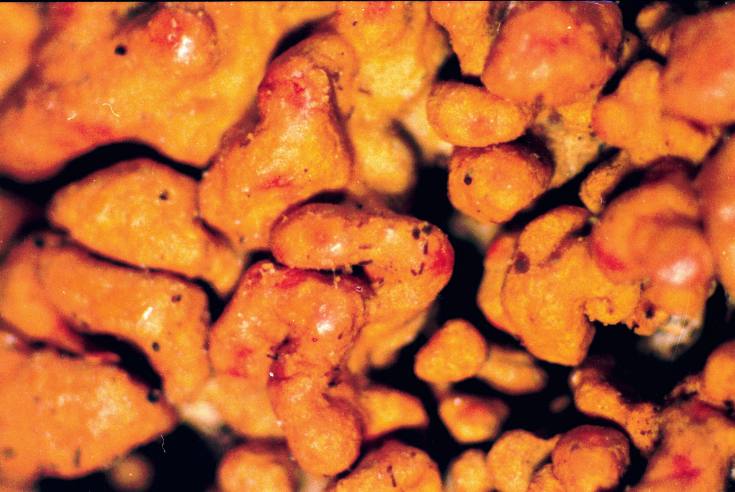Rusavskia Elegans on:
[Wikipedia]
[Google]
[Amazon]
''Rusavskia elegans'' (formerly ''Xanthoria elegans''), commonly known as the elegant sunburst lichen, is a

lichen
A lichen ( , ) is a composite organism that arises from algae or cyanobacteria living among filaments of multiple fungi species in a mutualistic relationship.Rusavskia
''Rusavskia'' is a genus of lichen-forming fungi in the family Teloschistaceae. It has 12 species. It is a member of the subfamily Xanthorioideae. The thallus of ''Rusavskia'' is characterized by its foliose lichen, foliose (leaf-like) structu ...
'', family Teloschistaceae
The Teloschistaceae are a large family of mostly lichen-forming fungi belonging to the class Lecanoromycetes in the division Ascomycota. The family, estimated to contain over 1800 species, was extensively revised in 2013, including the creation o ...
. Recognized by its bright orange or red pigmentation, this species grows on rocks, often near bird or rodent perches. It has a circumpolar and alpine
Alpine may refer to any mountainous region. It may also refer to:
Places Europe
* Alps, a European mountain range
** Alpine states, which overlap with the European range
Australia
* Alpine, New South Wales, a Northern Village
* Alpine National Pa ...
distribution. It was one of the first lichens to be used for the rock-face dating method known as lichenometry.
Taxonomy
''Rusavskia elegans'' was first formally described byJohann Heinrich Friedrich Link
Johann Heinrich Friedrich Link (2 February 1767 – 1 January 1851) was a German naturalist and botanist.
Biography
Link was born at Hildesheim as a son of the minister August Heinrich Link (1738–1783), who taught him love of nature throug ...
as ''Lichen elegans'' in 1791, and transferred to the genus ''Xanthoria
''Xanthoria'' is a genus of lichenized fungi in the family Teloschistaceae. Common names include orange lichen,
'' by Theodor Magnus Fries (son of Elias Magnus Fries
Elias Magnus Fries (15 August 1794 – 8 February 1878) was a Swedish mycologist and botanist.
Career
Fries was born at Femsjö (Hylte Municipality), Småland, the son of the pastor there. He attended school in Växjö.
He acquired ...
) in 1860. In 2003, Sergey Kondratyuk
Sergey Yakovlevich Kondratyuk ( uk, Сергій Якович Кондратюк) (born 17 May 1959) is a Ukrainian botanist specialising in lichenology. His research deals with the taxonomy, floristics, ecology and geography of lichens and lic ...
and Ingvar Kärnefelt
Jan Eric Ingvar Kärnefelt (born 1944) is a Swedish lichenologist.
Early life and education
Kärnefelt was born in Gothenburg, Sweden in 1944. His initial goal in his higher-level studies at University of Cologne in 1966–1967 was to become ...
transferred the taxon
In biology, a taxon (back-formation from ''taxonomy''; plural taxa) is a group of one or more populations of an organism or organisms seen by taxonomists to form a unit. Although neither is required, a taxon is usually known by a particular nam ...
to their newly circumscribed
In geometry, the circumscribed circle or circumcircle of a polygon is a circle that passes through all the vertices of the polygon. The center of this circle is called the circumcenter and its radius is called the circumradius.
Not every polyg ...
genus ''Rusavskia
''Rusavskia'' is a genus of lichen-forming fungi in the family Teloschistaceae. It has 12 species. It is a member of the subfamily Xanthorioideae. The thallus of ''Rusavskia'' is characterized by its foliose lichen, foliose (leaf-like) structu ...
'', in which it is the type species
In zoological nomenclature, a type species (''species typica'') is the species name with which the name of a genus or subgenus is considered to be permanently taxonomically associated, i.e., the species that contains the biological type specimen ...
. Although the new genus was not initially widely accepted, subsequent molecular phylogenetic
Molecular phylogenetics () is the branch of phylogeny that analyzes genetic, hereditary molecular differences, predominantly in DNA sequences, to gain information on an organism's evolutionary relationships. From these analyses, it is possible to ...
studies showed the validity of the new classification.
Description
Thethallus
Thallus (plural: thalli), from Latinized Greek (), meaning "a green shoot" or "twig", is the vegetative tissue of some organisms in diverse groups such as algae, fungi, some liverworts, lichens, and the Myxogastria. Many of these organisms wer ...
of this lichen is described as foliose, having the aspect of leaves, although the central portions of the thallus may appear nearly crustose. It is small, typically less than wide, with lobes less than broad, appressed to loosely appressed. The upper surface is some shade of orange while the lower surface is white, , with short, sparse (an attachment structure produced by some lichens). The vegetative propagules called soredia and isidia are absent, although apothecia are common. It has been described as possessing swollen, orange-yellow thalli (in streams), compact orange thalli (on boulders) or dark orange-red thalli on the driest rock faces.
The variety ''R. elegans'' var. ''granulifera'', characterized by having isidia
An isidium is a vegetative reproductive structure present in some lichens. Isidia are outgrowths of the thallus surface, and are corticated (i.e., containing the outermost layer of the thallus), usually with a columnar structure, and consisting o ...
-like vegetative propagules, has been reported from Greenland
Greenland ( kl, Kalaallit Nunaat, ; da, Grønland, ) is an island country in North America that is part of the Kingdom of Denmark. It is located between the Arctic and Atlantic oceans, east of the Canadian Arctic Archipelago. Greenland is t ...
and Spitsbergen
Spitsbergen (; formerly known as West Spitsbergen; Norwegian: ''Vest Spitsbergen'' or ''Vestspitsbergen'' , also sometimes spelled Spitzbergen) is the largest and the only permanently populated island of the Svalbard archipelago in northern Norw ...
.

Growth rate
''Rusavskia elegans'' was one of the first species used for lichenometry, a technique of estimating the age of rock faces by measuring the diameter of the lichen thalli growing on them. After an initial period of one or two decades to establish growth (theecesis
{{Short pages monitor